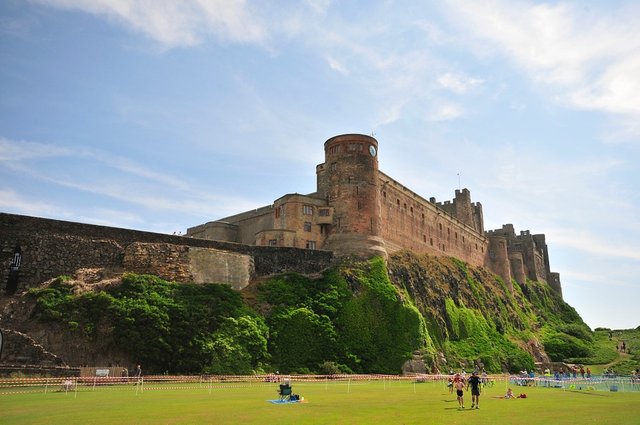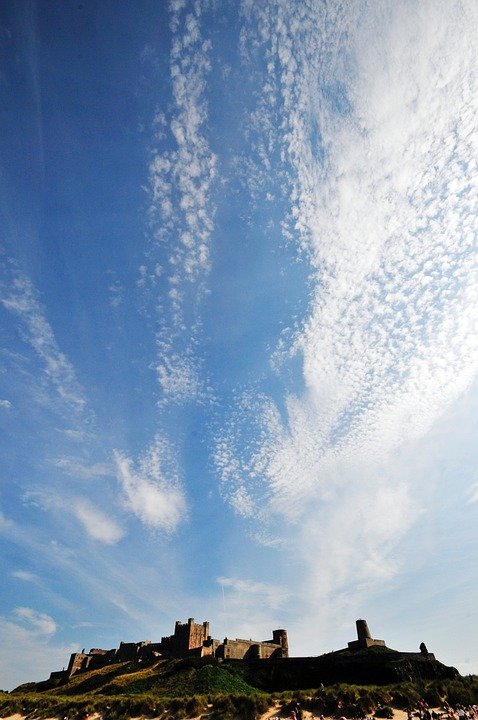The Nostalgic Bamburgh Castle in Northumberland
As this is on my doorstop I thought I would share such a lovely castle and a great piece of history.
It has happy memories for me as I worked on the guide book for Bamburgh in a previous profession and it is still there .

It actually spans nine acres of land on its rocky plateau high above the Northumberland coastline Bamburgh is one of the largest inhabited castles in the country.
Bamburgh’s written history begins in the times of the Anglo-Saxons with one chronicler citing Bamburgh as probably the most important place in all of England. But even before this there were people living here, there is archaeological evidence that as early as 10,000 BC there were people here. There are Bronze Age (2,400 -700BC) burials nearby and pottery sherds dating to the Iron Age (700 BC – 43AD). With little evidence of their occupation only the name Din Guayrdi gives us a hint that Romans were sometime between 43AD and 410AD.
It was during the early medieval period between 411AD and 1066AD that Bamburgh grew in stature and importance. With the arrival of the Saxons, the creation of an important Christian site and the coming and going of the saints Oswald, Aidan and Cuthbert, it was a pivotal time.
Following this period we saw the arrival of the Normans and the construction of our Great Tower, the culmination of the Wars of the Roses with the siege of 1464. The arrival of the Foster family, gifted the ruins by James 1 with the subsequent acquisition by Lord Crewe and the formation of the Crewe Trustees. A resurgence in stature as under the guidance of John Sharpe the castle became a leading surgery and dispensary for the poor and sick.
Finally the castle passed into the hands of the First Lord Armstrong, with the intention of creating a respite home he passed away before its restoration was complete and became the Armstrong family home. It is still owned by the Armstrong Family who opened it up to visitors in the mid 1900’s and remains to this day an icon of the North East of England.
Films made here..

Bamburgh Castle provided a stunning backdrop to the filming, which also features Sir Anthony Hopkins.
The arrival of the stars in the North East has generated huge excitement among movie-goers who have been out ion force trying to grab selfies with their favourite stars.
In the 3D sci-fi epic, Wahlberg plays Cade Yeager, while Spielberg is executive producer on the film, the fifth in the hit Transformers franchise, which is directed by Michael Bay.
This time Sir Anthony Hopkins has also joined the cast of the film which is due for release in 2017.
Hollywood giants Richard Burton and Peter O Toole filmed on the beach below the castle for Becket (1964), Charlton Heston and Sophia Loren walked the ramparts in El Cid (1961) while Elizabethan history has been represented here by Vanessa Redgrave as Mary Queen of Scots (1971) and Cate Blanchett as Elizabeth I (1998).
Pioneering director Ken Russell selected Bamburgh as the backdrop for his controversial shocker The Devils in 1971 while Roman Polanski filmed a blood drenched Macbeth the same year.
Standing on the castle ramparts towering over the North Sea it’s easy to see how this building has cast its spell over so many.
The sense of history and dominance is intoxicating. Seeing it in all its glory as you turn into Bamburgh from the south is a draw dropping experience.
For centuries the basalt outcrop on which Bamburgh Castle was built was a royal seat of power dating back to the native Britons. Records of a fortification on the site date from 547AD when it was taken by the Anglo Saxon king Ida of Bernicia. His son Hussa and then grandson Æthelfrith established the powerful kingdom of Northumbria. Æthelfrith, recognised by historians as the first Northumbrian king, passed the site, known then as Din Guiare, to his wife Bebba, from whom the early name Bebanburgh was derived
Vikings destroyed Bamburgh’s original fortification in 993 and not until the arrival of the Normans was a new castle constructed on the site; a structure which was to form the core of the castle we see today.
Bamburgh became the property of Henry II who is thought to have built the impressive castle keep. In 1464 during the Wars of the Roses, it became the first castle in England to be defeated by artillery during a nine-month siege led by Richard Neville, 16th Earl of Warwick.
The castle then entered a deserved period of peace with the Forster family of Northumberland in residence for over 400 years until the Crown granted full ownership to Sir John Forster.
The family retained ownership until Sir William Forster was posthumously declared bankrupt, and his estates, including the castle passed to Lord Crew, Bishop of Durham, under an Act of Parliament to settle the debts in 1700.
The castle deteriorated but was restored by various owners during the 18th and 19th centuries. However, it was Victorian industrial William Armstrong who completed the restoration and left his own unmistakable stamp on the building.
As a tribute to Armstrong the castle now houses the fascinating Armstrong and Aviation Artefacts Museum. In keeping with the castles brutal past its exhibits include engines, artillery and weaponry and aviation artefacts from two world wars that were produced by Armstrong Whitworth.
images courtesy of Pixabay
I just watched a Time Team special on Bamburgh.
Thanks Rich.. Its a great castle and literally on my doorstep. Hope the programme was good
It's one of my Y-Tube favorites... I really liked this episode. These guys are really great when it comes to English history. The "Real DaVinci Code" is incredible.
Great video and programme Rich. Oddly I have seen this channel before
I don't know why, being Italian/American, but I've always been fascinated by English history.
Great article! Thanks. The sky in that one picture is so big. It's an interesting composition!
Many thanks